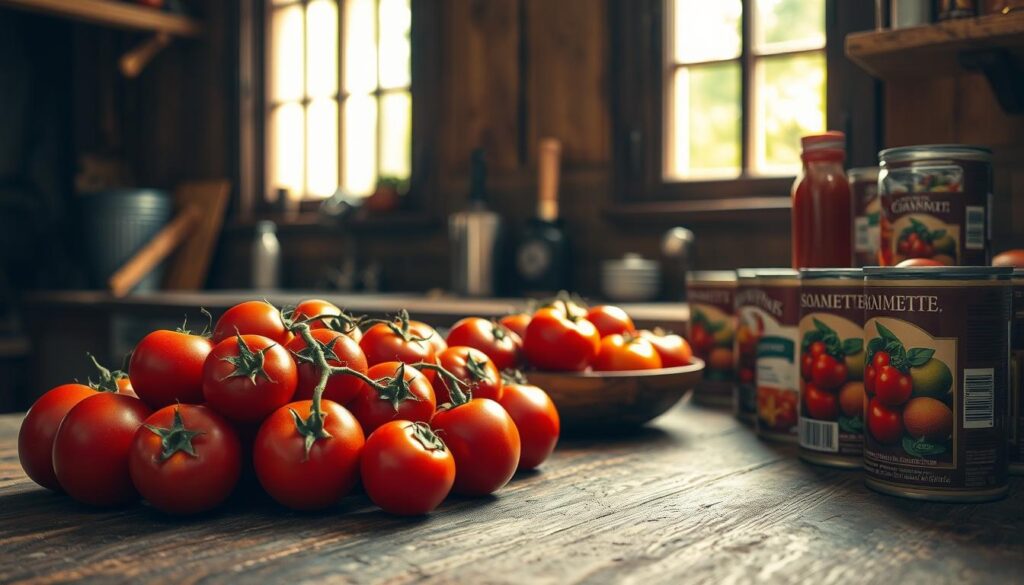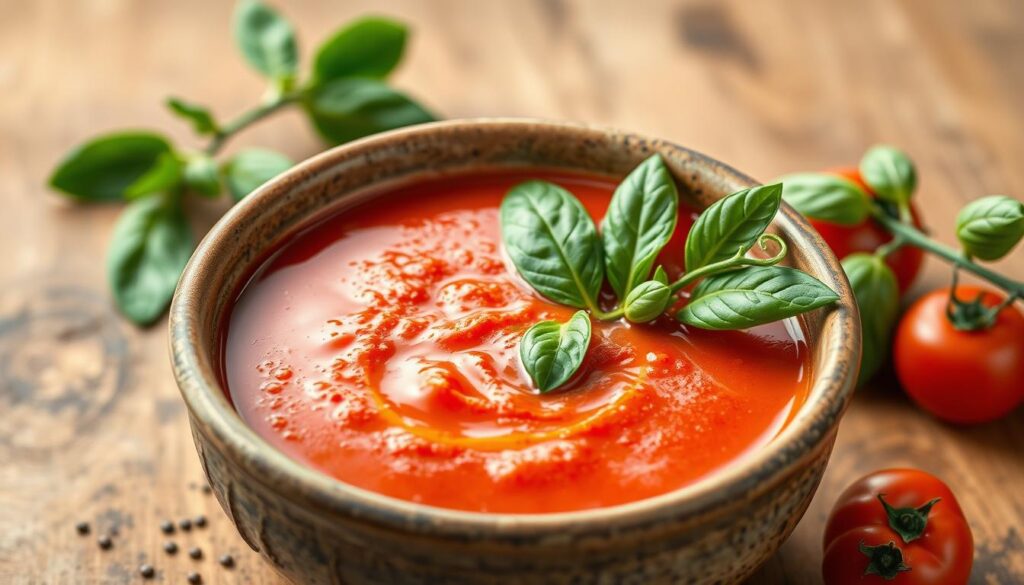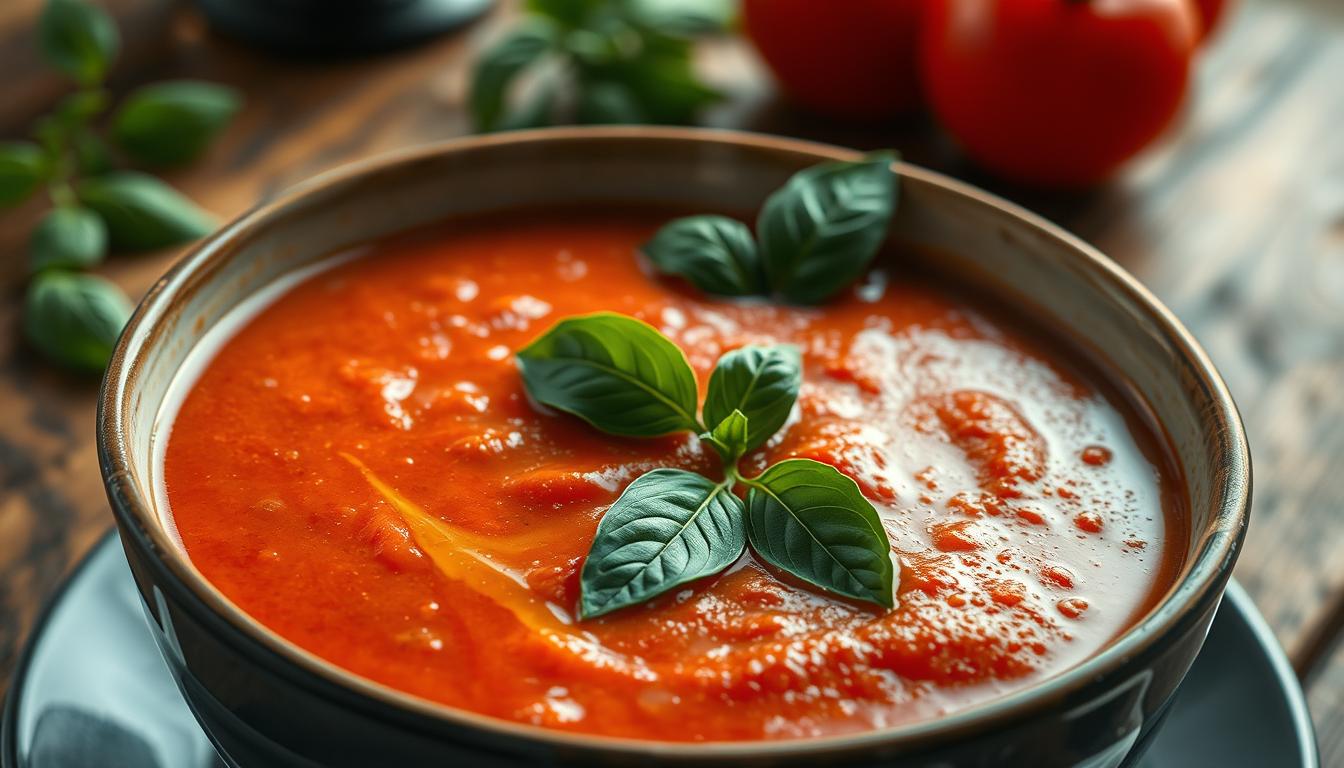Imagine a cold winter evening, wrapped in a cozy blanket. You have a steaming bowl of the best tomato soup warming your hands and soul. This delicious tomato soup is more than a meal—it’s a comfort experience. It turns simple ingredients into an extraordinary culinary journey.
Making the perfect tomato soup is an art that blends simplicity with amazing flavor. With just 20 minutes of prep, you can make a dish that’s both tasty and nutritious. Each serving has only 123 calories and is full of nutrients to nourish your body.
Whether you’re a seasoned home cook or new to the kitchen, this recipe will help you make a top-notch tomato soup. It will impress your family and friends. Get ready to learn the secrets of making the most delicious tomato soup you’ve ever tasted.
Key Takeaways
- Discover a quick and easy tomato soup recipe
- Learn how to create restaurant-quality flavor at home
- Enjoy a nutritious meal with only 123 calories per serving
- Master the art of roasting tomatoes for enhanced taste
- Explore versatile customization options for your soup
Best Tomato Soup Ever: A Classic Recipe Reimagined
Making the perfect homemade tomato soup is like creating a work of art. It turns simple ingredients into a dish fit for a restaurant. With a few expert tips and the right ingredients, your soup can be a hit.
The secret to great tomato soup starts with the right ingredients. Professional chefs say quality is more important than how complicated it is.
Essential Base Ingredients
- Fresh or canned whole peeled tomatoes (794 grams)
- Tomato paste (170 grams)
- Diced onions (2 cups)
- Garlic cloves (4 pieces)
- Fennel seeds (1 teaspoon)
The Secret to Restaurant-Quality Flavor
To make your tomato soup taste like it’s from a restaurant, use some pro techniques. The trick is to build flavors and let them grow.
| Technique | Impact on Flavor |
|---|---|
| Slow Simmering | Develops rich, concentrated taste |
| Optional Parmesan Rind | Adds umami complexity |
| Red Wine Splash | Introduces subtle depth |
Customizing Your Perfect Bowl
You can make your tomato soup your own. Try adding fresh basil, a bit of sugar, or different herbs and spices.
Pro tip: A quarter cup of fresh basil leaves can transform your soup from good to extraordinary!
Remember, the best tomato soup takes about 1 hour to simmer. Patience is key to its rich flavor.
The Art of Roasting Tomatoes for Superior Flavor
Turning an easy tomato soup into a gourmet dish starts with roasting tomatoes. This simple step boosts the natural sweetness and flavor. It makes your soup go from good to great.
Roasting tomatoes needs patience and care. Heat your oven to 225 degrees Fahrenheit for slow-roasting. It takes 8-10 hours. This low heat makes the tomatoes’ sugars concentrate, adding a rich flavor to your soup.
- Preparation time: 30 minutes
- Roasting temperature: 225°F
- Total cooking time: 8-9 hours
- Recommended tomato quantity: 1 peck (12-15 tomatoes)
For the best flavor in your easy tomato soup, follow these tips:
- Choose ripe, fresh tomatoes
- Slice tomatoes into even pieces
- Drizzle with olive oil
- Season with salt and pepper
- Spread on a baking sheet in a single layer
The magic of roasting is in caramelization. As tomatoes roast slowly, their sugars concentrate. This creates a deep, complex flavor that makes your soup rich and vibrant. It will impress anyone who tries it.
Pro tip: Roasting tomatoes can turn a simple soup into a gourmet experience with minimal extra effort.
After roasting, store your tomatoes in the fridge for up to 5 days. Or freeze them for up to 6 months. This way, you always have a flavorful base for your next easy tomato soup.
Mastering the Creamy Texture: Tips and Techniques
Making the perfect creamy tomato soup needs skill and care. To get a smooth tomato bisque soup, learn the essential techniques. These will turn a simple soup into a dish fit for a restaurant.
Choosing the Right Cream Base
The cream base you pick is key to a great creamy tomato soup. Here are some choices:
- Heavy cream for traditional richness
- Half-and-half for lighter consistency
- Coconut milk for dairy-free alternatives
- Cashew cream for a plant-based option
Blending Methods for Silky Smoothness
Getting the right texture is all about blending. Use an immersion blender for smoothness right in the pot. For even silkier soup, strain it through a fine-mesh sieve to get rid of tomato seeds or skin.
Achieving the Perfect Consistency
Adjust the soup’s thickness by changing the liquid amount. Start with less liquid and add more as needed. Chefs often add a bit of cornstarch or flour to thicken without losing flavor.
Pro tip: Always blend hot soup carefully to prevent splattering and possible burns.
With these tips, you’ll make a creamy tomato soup as good as any fancy restaurant. Remember, it’s all about patience, trying new things, and knowing how ingredients work together for that silky texture.
Fresh vs. Canned Tomatoes: Making the Right Choice

Choosing between fresh and canned tomatoes is key for your homemade tomato soup. Each choice affects the taste and texture of your soup. Fresh tomatoes add a burst of flavor, while canned tomatoes offer convenience and quality.
Fresh tomatoes are best in summer, with their bright taste and perfect ripeness. They need more work but taste amazing. Here’s how to use them:
- Select ripe, deep-red tomatoes
- Blanch in boiling water for 2-3 minutes
- Transfer to an ice bath
- Easily peel off the skins
- Chop and use in your soup
Canned tomatoes are easy to use and taste great all year. San Marzano tomatoes are a top pick for their sweet taste. They’re processed quickly after picking, ensuring flavor consistency.
Think about these points when picking tomatoes for your soup:
- Seasonality of fresh tomatoes
- Preparation time available
- Desired flavor intensity
- Cost of ingredients
Pro tip: If fresh tomatoes are hard to find, use two 28-ounce cans of whole peeled tomatoes. This way, you’ll get a tasty, healthy soup all year round.
Elevating Your Soup with Herbs and Seasonings
Making a delicious tomato soup is all about mixing flavors with the right herbs and seasonings. It’s like turning a simple soup into a masterpiece. You just need to know how to pick the right seasonings.
In a vegetarian tomato soup, herbs are key to adding depth. About 75% of recipes suggest using basil. It can be fresh or dried, to boost the flavor.
Classic Herb Combinations
Here are some herb pairs that can make your soup better:
- Fresh basil leaves for a bright, aromatic touch
- Dried oregano used sparingly (recommended by 80% of culinary experts)
- Thyme for subtle floral notes
Balancing Flavors with Spices
Spices are the magic that makes a delicious tomato soup stand out. Try these:
- Freshly ground black pepper (used by 70% of soup enthusiasts)
- Garlic powder (1/2 tsp recommended)
- Cayenne pepper for a subtle kick (1/4 tsp)
Fresh Garnish Ideas
Make your vegetarian tomato soup pop with these garnishes:
- Toasted pumpkin seeds
- Fresh herb sprigs
- A drizzle of high-quality olive oil
- Cracked black pepper
The secret to a great soup is tasting and adjusting as you go. Start with a little and add more until it’s just right. This way, you’ll create a soup that’s sure to impress.
Perfect Pairings: What to Serve with Tomato Soup
Your classic tomato soup needs the perfect side to make it unforgettable. The right choice can turn a simple meal into a special experience. It will satisfy your hunger and delight your taste buds.
Grilled cheese sandwiches are the top choice to go with tomato soup. This classic combo has been a favorite for nearly a century. It offers a creamy soup and crispy, melted cheese that brings back memories.
- Classic Sandwich Pairings:
- Traditional grilled cheese
- Pulled pork sandwiches
- Leftover meatloaf sandwiches
- Bread Options:
- Garlic bread
- Focaccia
- Breadsticks
- Crusty rolls
Looking for something other than sandwiches? Here are some tasty alternatives for your tomato soup:
- Appetizer Options:
- Mozzarella sticks
- Caprese skewers
- Stuffed mushrooms
- Salad Companions:
- Chopped salad
- Caprese salad
- Pasta salad
“A great soup is only as good as its accompaniments” – Culinary Wisdom
Roasted vegetables can make your meal more nutritious and flavorful. Try broccoli, cauliflower, asparagus, or green beans with your tomato soup. For a heartier choice, pasta like mac and cheese or buttered noodles pairs well.
Pro tip: Add a touch of elegance to your tomato soup. Sprinkle shredded cheese, add oyster crackers, or garnish with fresh herbs. It will look like it came from a restaurant.
Storage Tips and Meal Prep Strategies
Preparing a delicious homemade tomato soup recipe needs smart storage and planning. Meal prep can cut down your daily cooking stress. It ensures you always have a healthy tomato soup ready to enjoy.
Batch cooking your favorite soup can save up to 50% on meal prep time. By using strategic storage techniques, you’ll keep both flavor and convenience high.
Freezing Methods for Long-Term Storage
Freezing your homemade tomato soup is a great way to keep its rich flavor. Follow these key steps:
- Cool the soup completely before freezing
- Use freezer-safe containers with tight-fitting lids
- Leave about 1 inch of space at the top for expansion
- Label containers with the date of preparation
Reheating Guidelines
When you’re ready to enjoy your healthy tomato soup, proper reheating is key. It keeps the taste and texture right:
| Storage Location | Reheating Method | Recommended Time |
|---|---|---|
| Refrigerator | Stovetop or Microwave | 3-4 days |
| Freezer | Thaw overnight, then reheat | Up to 3 months |
Portion Control Tips
Strategic portioning helps manage meal sizes and reduce food waste. Consider these strategies:
- Use individual portion containers
- Freeze soup in 1-2 cup servings
- Plan meals around your soup portions
By using these storage and meal prep strategies, you’ll make your homemade tomato soup a convenient, nutritious meal. It saves time and reduces daily cooking stress.
Health Benefits and Nutritional Value

Learn why a healthy tomato soup is a nutritional gem for your diet. It’s not just tasty; it’s also packed with essential nutrients. A single serving can offer remarkable health benefits that boost your overall wellness.
The nutritional profile of tomato soup is truly impressive. Here are key health advantages:
- Low in calories (only 33 calories per large tomato)
- Rich in lycopene, providing 80% of daily recommended intake
- Supports heart health through powerful antioxidants
- Boosts immune system with high vitamin C content
Lycopene, the star nutrient in tomato soup, offers significant health protection. Research shows it can reduce cancer risks by up to 28% and improve heart health. Your body will thank you for adding this nutrient-dense soup to your diet.
“Food is the most powerful medicine” – Hippocrates
Nutritional highlights of a typical serving include:
- 7 grams of carbohydrates
- 2 grams of fiber
- 1.6 grams of protein
- 40mg of vitamin C (44% daily value)
For those managing specific health concerns, vegetarian tomato soup is a great choice. Its chromium helps regulate blood sugar, making it good for diabetics. The high water content (84%) also supports hydration.
Troubleshooting Common Tomato Soup Issues
Making the best tomato soup ever can be tricky. Even skilled cooks face problems. Knowing common issues helps turn a simple soup into a hit with your loved ones.
Let’s look at some tips to improve your tomato soup recipe. The right ingredients are key.
- Acidic Soup Solution: Balance overly tangy tomatoes by adding a pinch of sugar or a splash of cream
- Flavor Depth Enhancers: Use roasted garlic, smoked paprika, or sun-dried tomatoes for complex taste
- Texture Corrections: Blend carefully to achieve smooth consistency without over-processing
For texture problems, try these methods:
| Issue | Solution |
|---|---|
| Watery Soup | Simmer longer or add tomato paste |
| Grainy Texture | Strain through fine-mesh sieve or use immersion blender |
| Lacks Creaminess | Add heavy cream or blend with cottage cheese |
Remember, practice is key to making the best tomato soup. Don’t worry about first-time failures. Each try teaches you more about flavor balance and texture.
Conclusion
Making homemade tomato soup is more than just following steps. It’s about creating a special experience. You’ve shown that you can make restaurant-quality soup right in your kitchen.
By roasting tomatoes and balancing flavors, you’ve turned simple ingredients into a delicious meal. This shows how easy it is to make something amazing.
This tomato soup is very versatile. It can feed 4-6 people or just you, making it perfect for any occasion. You can add cream and herbs to make it your own.
Remember, cooking is all about exploring. Your tomato soup recipe can change with each try. You can try new spices and make it your own.
Each bowl of soup is not just food. It’s a way to express yourself through cooking. It connects you to a long tradition of home cooking.
Keep trying new things and enjoy making soups that warm your heart and body. Your kitchen is your canvas, and this tomato soup recipe is your first masterpiece.

